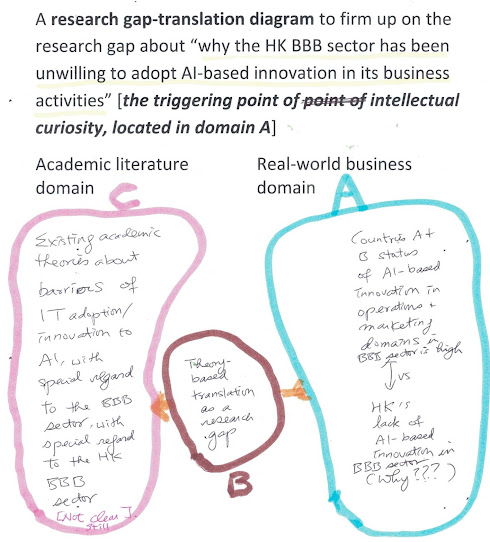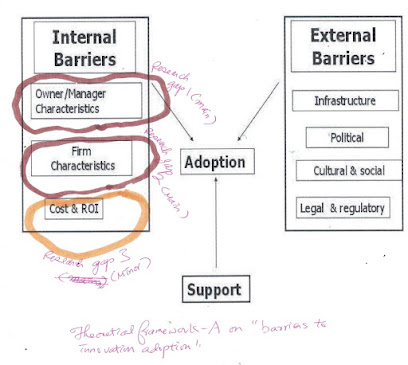The following note, drawing on my classroom brain-storming exercise with an MBA student, introduces a generic research gap -translation exercise to firm up on a research gap idea for an academic-orientated research project.
Regarding the triggering point of intellectual curiosity [TPIC] from the MBA student, it can be stated as follows: "why the HK BBB sector has been unwilling to adopt AI-based innovation in its business activities". With this formulated triggering point of intellectual curiosity, I now work on the research gap-translation exercise to firm up on the cogent research gap idea [RTE for an academic-oriented research project (that employs the agile literature review approach). Such a research gap translation diagram comprises three components:
Component A: A particular real-world situation as conceived by the triggering point of intellectual curiosity of the researcher (i.e. the real-world business domain [RWBD]).
Component B. An imaginative leap by the researcher to work on the theory-based translation as a research gap [TBT(RGF)] formation
Component C. The derived theory-based academic theme [DTAT] in the academic literature domain (based on the TBT[RG]) pointing to the relevant academic literature for conducting a focused preliminary literature review. Such a theme could be formulated as a gross research gap position statement so as to be more usable to develop specific research gap items subsequently.
A research gap-translation diagram, as illustrated in the following example, depicts the relationship between the three components of the RTD.
Now, with the research gap-translation diagram, the researcher can conduct the preliminary literature review and preliminary research (e.g. desk research and/or interview research) to develop a firmer idea on the research gap statement, such as:
Research gap item 1: the existing academic literature on IT (notably AI) based innovation does not adequately offer relevant academic concepts and theories for investigation application on the real-world phenomenon of "why the Hong Kong BBB sector has been unwilling to adopt AI-based innovation in its business activities".
In response to research gap item 1, the following research objective is proposed:
Research objective 1: to generate original academic knowledge that contribute to the enhancement of academic concepts and theories on IT (notably AI) based innovation barriers for the HK BBB sector.
In summary, this note introduces the agile literature review approach technique of the research gap translation exercise to firm up on a research gap idea. Such an exercise is depicted with a set of specific terms such as (i) the triggering point of intellectual curiosity [TPIC], (ii) the research gap-translation exercise to firm up on the cogent research gap idea [RTE], (iii) the real-world business domain [RWBD], (iv) the theory-based translation as a research gap [TBT(RGF)], (v) the derived theory-based academic theme [DTAT], (vi) the research gap item #, (vii) research objective #, and (viii) the academic literature domain [ALD]. Both the research gap analysis and the subject research project require additional literature review efforts and research methods application efforts so as to produce research findings to meet the stated research objective. The agile literature review approach to guide such a research project is further clarified in a study note (re: the study notes).
Notes :
Note 1: the "richness" of the research gap-translation diagram is to be revealed by the preliminary literature review and research methods efforts by the researcher. The preliminary findings that clarify the research gap and research objective are to be presented in the researcher's research proposal and final dissertation report. The findings are described further by the four deliverables of the agile literature review approach. Note 2: for the example provided in this note, to conduct the preliminary literature search, the researcher (e.g. the MBA student researcher) could go to google scholar and type "barriers to technological innovation" for a start.
A related methodological issue is also examined here.
Assume that you have already identified the main research objective as follows:
Research objective 1: to generate original academic knowledge that contribute to the enhancement of academic concepts and theories on IT (notably AI) based innovation barriers for the HK BBB sector.
Now, after doing some literature review on the topic of innovation barriers, you realize that the main theories can be further divided into a number of sub-topics, as represented in the following theoretical framework (which I quickly identify by typing "barriers to innovation adoption" and do google search with the filter of "images"; re: image source):
Now then, assume that, with your preliminary literature review, you are particularly interested in 2 main sub-topics with some specific research gaps (e.g. in the form of concept vagueness, incompatible theories, etc.) and 1 minor sub-topic. You are now ready to map them into the theoretical framework in the form of 2 main research gaps and 1 minor research gap, shown as follows [
Theoretical framework-A]:
It is quite likely that your theoretical framework has adopted some local context considerations (e.g. on the Hong Kong restaurant sector, with specific regard to AI adoption), thus a bit more complicated than the theoretical framework provided here. Regardless, with the theoretical framework-A provided, I can now come up with three related research gaps, 2 major ones and 1 minor one [that are made up by me for illustration purpose]:
Research gap 1 (main): an inadequate empirical study of the internal innovation barrier of "owner/ manager characteristics" with regard to the HK BBB sector on AI applications.
Research gap 2 (main): a lack of conceptual agreement in the academic literature on the internal innovation barrier of "firm characteristics", especially with regard to the HK BBB sector on AI applications.
Research gap 3 (minor): Unclear academic methodologies for investigating the internal innovation barrier of "[innovation project] cost/ ROI [evaluation]" especially with regard to the HK BBB sector on AI applications.
It is also feasible to derive the corresponding main and minor research objectives such as:
Research objective 1 (main): to conduct empirical research in HK to gain more understanding on the internal innovation barrier of "owner/ manager characteristics" with regard to the HK BBB sector on AI applications.
Research objective 2 (main): to conduct empirical research in HK to gain more understanding (including conceptual agreement) on the internal innovation barrier of "firm characteristics", especially with regard to the HK BBB sector on AI applications.
Research objective 3 (minor): to conduct empirical research in HK to inform the development of a methodology for investigating the internal innovation barrier of "[innovation project] cost/ ROI [evaluation]" especially with regard to the HK BBB sector on AI applications.
Making reference to the two main research objectives (which constitute the core-focus-domain of the dissertation project, I can now derive the dissertation project title as follows:
Project title: An investigation on the innovation barriers of "owner/manager characteristics" and "firm characteristics" with regard to AI-application for the Hong Kong BBB sector: an academic-oriented research project.
Lastly, by mapping chosen research methods onto the theoretical framework-A, I come up with the following theoretical framework-B:




Also refer to the pdf version of the note: https://www.academia.edu/104457407/A_note_on_the_rich_picture_exercise_to_firm_up_on_a_research_gap_idea
ReplyDelete